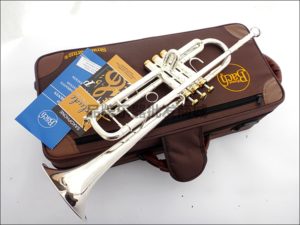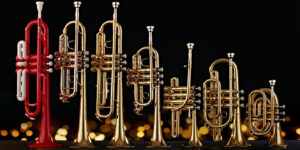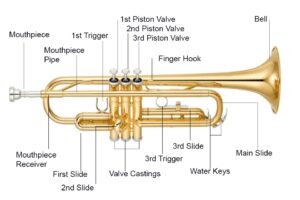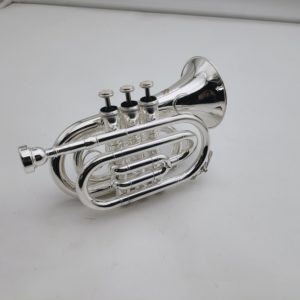History and Enchanting Sounds of the Trumpet
Listen to the Audio “Exploring the History and Enchanting Sounds of the Trumpet”

With its resonant notes and soul-stirring melodies, the trumpet has long captivated audiences and stood proudly on centre stage in the world of music. From its humble origins in ancient civilizations to its prominent role in orchestras and jazz bands, the trumpet’s rich history is as intriguing as the enchanting sounds it produces.
Dating back over two thousand years, the trumpet has evolved and adapted, earning its place as one of the most iconic and versatile instruments. Its piercing highs and smooth lows effortlessly convey a wide range of emotions, leaving listeners in awe of the musician’s skill.
In this article, we delve into the captivating story of the trumpet, tracing its roots and exploring the milestones that shaped its evolution. From the royal courts of Europe to the birth of jazz and beyond, we unravel the secrets behind the trumpet’s enduring allure.
Join us as we are transported through time and immerse ourselves in the melodic magic of the trumpet, celebrating the centuries of artistry and innovation that have made it an indispensable part of our musical heritage.
The History of the Trumpet
The history of the trumpet is a fascinating journey that spans thousands of years and various civilizations. Here’s a brief overview:
- Ancient Origins: Trumpet-like instruments have been in existence since ancient times. The earliest known trumpets date back to around 1500 BC and were used by civilizations such as the Egyptians and the Hittites. These early trumpets were often made from animal horns or shells.
- Roman Trumpets: The Roman Empire had a significant influence on the development of the trumpet. They used a straight trumpet called the “tuba” in military and ceremonial contexts. These instruments were often made from bronze or silver.
- Medieval and Renaissance Eras: During the Middle Ages and the Renaissance, various forms of trumpets were used in Europe. These trumpets often had distinct shapes, including S-shaped and coiled designs. They were used in both military and courtly settings.
- Baroque Era: The trumpet underwent significant changes during the Baroque period (17th and 18th centuries). The addition of keys and valves allowed for more complex melodies and improved intonation. Trumpet music from this era, such as that composed by Bach and Handel, remains popular today.
- 19th Century: The invention of the valve trumpet in the early 19th century revolutionized the instrument. Valve mechanisms allowed trumpet players to change the pitch of the instrument more easily, expanding its range and versatility.
- 20th Century: The trumpet continued to evolve in the 20th century. Jazz musicians like Louis Armstrong and Miles Davis played a crucial role in popularizing the trumpet as a solo instrument. The development of different trumpet models, such as the piccolo trumpet and flugelhorn, added diversity to the trumpet family.
- Contemporary Trumpet: Today, the trumpet is a versatile instrument used in various musical genres, from classical orchestras to jazz bands and even rock and pop music. Modern trumpets typically have three piston valves or rotary valves that allow for precise pitch control.
Throughout its history, the trumpet has played a vital role in both military and artistic contexts. It continues to be a symbol of power, celebration, and musical expression in cultures around the world.
Different Types of Trumpets

Certainly, there are several different types of trumpets, each with its unique characteristics and purposes. Here are some of the most common types of trumpets:
- Bb Trumpet: The Bb (B-flat) trumpet is the most common type of trumpet and is widely used in various music genres, including classical, jazz, and popular music. It is known for its bright and versatile sound and is often the first choice for beginners.
- C Trumpet: The C trumpet is slightly smaller than the Bb trumpet and is used primarily in orchestral settings. It has a slightly brighter sound and is favoured for its ability to blend well with other orchestral instruments.
- Piccolo Trumpet: The piccolo trumpet is a smaller trumpet with a higher pitch. It is known for its bright and piercing sound and is often used in Baroque music, particularly in pieces by composers like Bach and Handel. Piccolo trumpets typically have four valves, which extend their range.
- Flugelhorn: The flugelhorn is a cousin of the trumpet but has a distinct conical shape and a mellow, warm sound. It is commonly used in jazz and brass bands and is known for its lyrical and expressive qualities.
- Pocket Trumpet: As the name suggests, pocket trumpets are compact and portable versions of the Bb trumpet. They are designed for travel and practice and can be a fun alternative for trumpet players on the go.
- Herald Trumpet: Herald trumpets, also known as fanfare trumpets, are long, straight trumpets with a ceremonial and majestic sound. They are often used in royal and official events, such as ceremonies and processions.
- Rotary Valve Trumpet: Rotary valve trumpets, also known as German trumpets, have rotary valves instead of piston valves. They are commonly used in German and Austrian music and have a distinctive sound.
- Slide Trumpet: The slide trumpet is similar in appearance to a trombone but is played like a trumpet. Instead of valves, it has a slide mechanism for changing the pitch. It was popular in the Renaissance period and is rarely used today.
- Natural Trumpet: Natural trumpets are historical instruments without valves or keys. They require the player to use their embouchure and lip control to produce different notes. They are often used in historically informed performances of Baroque music.
These are just a few examples of the many types of trumpets that exist. Each type has its own unique characteristics and is suited to different musical styles and contexts. Trumpets continue to evolve, and custom variations are also created to meet the specific needs of musicians.
The Anatomy of a Trumpet

The trumpet is a brass instrument with a relatively simple yet highly effective design. Understanding its anatomy is essential for players and enthusiasts. Here are the main parts and components of a trumpet:
- Bell: The bell is the flared, open end of the trumpet. It’s responsible for projecting the sound produced by the instrument. The shape of the bell affects the timbre and resonance of the trumpet.
- Lead pipe: The lead pipe is the first section of tubing that connects the mouthpiece to the main body of the trumpet. It plays a crucial role in shaping the instrument’s sound and resistance.
- Valve Casing: Trumpets typically have three piston valves, each housed in a valve casing. These valves are responsible for altering the length of tubing and, consequently, changing the pitch of the notes played.
- Valve Pistons: The valve pistons are the moving parts inside the valve casings. When you press the valve buttons, the pistons move up and down to redirect the airflow through different lengths of tubing, allowing for various notes to be played.
- Valve Buttons: These are the round, finger-operated buttons that you press to engage the valve pistons. The order in which you press the valves determines the pitch of the note produced.
- Main Tuning Slide: The main tuning slide is a movable section of tubing that connects the lead pipe to the valve casings. Players can adjust the length of the main tuning slide to fine-tune the overall pitch of the trumpet.
- Water Keys: Also known as spit valves, water keys are small, spring-loaded valves located at various points on the trumpet, including the main tuning slide and third valve slide. They allow moisture and condensation to be easily drained from the instrument.
- Third Valve Slide: The third valve slide is an adjustable section of tubing that can be extended or retracted. It is primarily used to lower the pitch of the trumpet when playing specific notes.
- Slides: Trumpets have several slides that can be adjusted to fine-tune the instrument’s intonation. These include the first and third valve slides and the main tuning slide.
- Mouthpiece Receiver: The mouthpiece receiver is the opening at the end of the lead pipe where the mouthpiece is inserted and secured. The choice of mouthpiece can significantly affect the trumpet’s playability and sound.
- Finger Hook or Ring: This is a small metal loop or ring attached to the third valve casing. It provides a place for the player’s little finger to rest while holding the trumpet.
- Braces: Braces are metal rods that connect various parts of the trumpet to provide structural support and stability. They can be found on the lead pipe, valve casings, and elsewhere.
- Brass Material: The trumpet is typically made of brass, which is a combination of copper and zinc. The specific alloy and thickness of the brass affect the instrument’s tonal characteristics and durability.
Understanding the anatomy of a trumpet is essential for players to maintain their instruments, make adjustments for tuning, and develop the skills needed to play it effectively. Each component plays a vital role in producing the trumpet’s distinctive sound.
How to Play the Trumpet
Learning how to play the trumpet takes time, practice, and dedication. Here’s a step-by-step guide to get you started:
- Get the Right Equipment:
Obtain a trumpet: Choose a quality trumpet suitable for beginners. Consult with a music teacher or a professional player for recommendations.
Select a mouthpiece: The mouthpiece is crucial for sound production. Start with a standard-sized mouthpiece recommended for beginners.
- Proper Posture and Holding the Trumpet:
Stand or sit up straight, maintaining good posture.
Hold the trumpet with your left hand while placing your right hand on the valve casing.
Keep your fingers relaxed and curved around the valve buttons.
- Embouchure:
Your embouchure is the way you use your lips, facial muscles, and airflow to produce sound.
Form a tight seal around the mouthpiece with your lips.
Create a buzzing sound by blowing air through the small opening between your lips and the mouthpiece. Practice buzzing without the trumpet to develop control.
- Basic Buzzing and Pitch Control:
Experiment with buzzing different pitches using your embouchure.
Try to produce steady, controlled pitches. This helps develop your ear for intonation.
- Breathing Techniques:
Learn proper breathing techniques for trumpet playing. Take deep breaths from your diaphragm to support your sound.
Practice long tones, holding a single note for an extended period, to build breath control.
- Tone Production:
Place the mouthpiece in the trumpet’s mouthpiece receiver.
With your embouchure and proper airflow, produce a clear, focused sound on the open (valveless) notes of the trumpet.
Focus on producing a rich and full tone.
- Valve Fingerings:
Start by learning the fingerings for the three valve buttons (1st, 2nd, and 3rd valves).
Experiment with different combinations of valve fingerings to produce different pitches.
- Scales and Basic Songs:
Begin with simple scales, such as the C major scale, to practice finger dexterity and pitch control.
Gradually move on to basic songs and melodies. Start with songs that use a limited range and progress to more complex pieces.
- Practice Regularly:
Consistent practice is key to improvement. Establish a practice routine that includes warm-ups, scales, exercises, and songs.
Set specific goals for each practice session.
- Seek Guidance:
Consider taking lessons from a qualified trumpet teacher. They can provide valuable feedback, guidance, and personalized instruction.
Join a school band, community ensemble, or online forums to connect with other trumpet players and gain experience.
- Maintenance:
Clean your trumpet regularly to keep it in good condition.
Oil the valves as needed to ensure smooth operation.
Check for any damage or wear on your instrument.
- Ear Training:
Train your ear to recognize pitches and intonation. Play along with a tuner or a piano to improve your pitch accuracy.
- Performance and Expression:
As you advance, focus on musical expression and dynamics in your playing. Trumpet music can convey a wide range of emotions.
Remember that progress on the trumpet can be gradual, so be patient with yourself. Consistent practice, along with guidance from a teacher, will help you develop your skills and enjoy the process of making music with this beautiful instrument.
Techniques and Styles of Trumpet Playing
Trumpet playing encompasses a wide range of techniques and styles, each requiring specific skills and approaches. Here are some of the most common techniques and styles of trumpet playing:
Techniques:
- Embouchure Control: A solid embouchure is the foundation of trumpet playing. It involves the precise control of lip tension and positioning to produce different pitches and tones.
- Breath Control: Proper breath control is essential for sustained playing, controlling dynamics, and achieving a full tone. Learning to take deep breaths and use your diaphragm effectively is crucial.
- Articulation: Articulation refers to how you start and stop notes. Techniques like tonguing (using your tongue to start a note) and slurring (moving smoothly between notes without tonguing) are essential for various styles of trumpet playing.
- Vibrato: Vibrato is a subtle variation in pitch used for expressive purposes. Trumpet players can use lip vibrato, which involves altering lip tension, to add warmth and emotion to their playing.
- Trills: Trills involve rapidly alternating between two adjacent notes. They are often used for ornamentation and to add excitement to trumpet solos.
- Mutes: Mutes are devices placed in the bell of the trumpet to change its sound. Different mutes produce unique timbres, such as the bright sound of a straight mute or the muted, sombre tones of a cup mute.
- Double Tonguing and Triple Tonguing: These techniques are used in faster passages to articulate notes more rapidly. Double tonguing involves alternating between syllables (e.g., “ta” and “ka”), while triple tonguing adds a third syllable (e.g., “ta-ka-ta”).
- High Range Playing: Trumpet players often work on extending their high range. This requires building strength and control in the upper register of the instrument.
- Flutter Tonguing: Flutter tonguing is a technique where the player flutters their tongue while blowing air into the trumpet, creating a raspy, fluttering sound.
Styles:
- Classical: Classical trumpet playing encompasses a wide range of genres, from orchestral music to solo trumpet repertoire. Precision, control, and a clear tone are essential in classical trumpet playing.
- Jazz: Jazz trumpet playing emphasizes improvisation, expressive phrasing, and a wide range of stylistic elements, including swing, bebop, and cool jazz. Players often use various mutes for different effects.
- Blues: Blues trumpet playing focuses on soulful, expressive playing. It involves bending notes, using growls, and conveying deep emotions through the instrument.
- Marching Band: Trumpet players in marching bands require strong projection, precision, and the ability to play while moving. Marching band music includes marches, pep tunes, and other lively compositions.
- Latin and Salsa: In Latin and salsa music, trumpet players use a variety of techniques, including rapid tonguing and extended high notes. They often play catchy melodies and syncopated rhythms.
- Rock and Pop: Trumpet players in rock and pop bands may provide horn sections, solos, and melodic lines. The style varies widely, from soulful ballads to energetic rock anthems.
- Contemporary and Experimental: Some trumpet players explore contemporary and experimental styles, incorporating extended techniques, electronics, and unconventional sounds into their playing.
- Big Band: In big band music, trumpet players are often part of a brass section. They play in harmony with other brass instruments and provide powerful, ensemble-driven performances.
- Orchestral: Orchestral trumpet players perform in symphony orchestras and are skilled at blending their sound with other brass and woodwind instruments. They play a wide range of classical compositions.
- Funk: Funk trumpet players contribute to the groove and rhythm of funk music. They use techniques like staccato articulation and syncopation to create a tight, danceable sound.
The trumpet is a versatile instrument with a rich history in various musical genres. Depending on your interests and goals, you can explore different techniques and styles to find your own unique voice as a trumpet player.
Tips for Beginners Learning the Trumpet
Learning to play the trumpet as a beginner can be both exciting and challenging. Here are some valuable tips to help you get started and progress in your trumpet playing:
- Get Proper Equipment:
Start with a good-quality student trumpet. Consult with a teacher or an experienced player for recommendations.
Choose a suitable mouthpiece. A standard-sized mouthpiece is ideal for beginners.
- Find a Qualified Teacher:
Consider taking lessons from a skilled trumpet teacher. A teacher can provide personalized guidance and help you develop proper technique from the beginning.
- Learn Proper Posture and Hand Position:
Stand or sit up straight with good posture. Proper posture allows for better breath control and embouchure development.
Hold the trumpet with your left hand and place your right hand on the valve casing. Keep your fingers relaxed and curved.
- Work on Your Embouchure:
Spend time developing your embouchure, which is the way you use your lips and facial muscles to create sound. Practice buzzing your lips without the trumpet to build control.
- Breathing Techniques:
Learn to take deep breaths from your diaphragm to support your sound. Breathing exercises can help improve your breath control.
- Start with Basic Exercises:
Begin with simple exercises like long tones and slurs. These will help develop your tone quality and lip flexibility.
Practice scales to familiarize yourself with different pitches and fingerings.
- Finger Dexterity:
Focus on finger dexterity exercises to build agility and precision in valve fingerings. Start with basic finger patterns and progress to more complex ones.
- Practice Regularly:
Establish a consistent practice routine. Short, daily practice sessions are more effective than infrequent, lengthy ones.
Set achievable goals for each practice session and track your progress.
- Listen and Learn:
Listen to trumpet players in various styles to understand different approaches to the instrument.
Study trumpet music and recordings to develop your musical ear.
- Use a Tuner:
Invest in a tuner to help you develop accurate pitch and intonation. Playing in tune is crucial for ensemble playing.
- Join a Music Group:
If possible, join a school band, community ensemble, or trumpet group. Playing with others is a great way to gain experience and improve your ensemble skills.
- Stay Patient and Positive:
Learning the trumpet can be challenging, and progress may be slow at times. Stay patient and maintain a positive attitude.
Celebrate your achievements, no matter how small they may seem.
- Record Yourself:
Record your playing regularly. Listening to recordings of your practice sessions can help you identify areas for improvement and track your progress.
- Seek Feedback:
Don’t hesitate to seek feedback from your teacher, fellow musicians, or online communities. Constructive criticism can be valuable for growth.
- Have Fun:
Remember that playing the trumpet should be enjoyable. Experiment with different styles and musical genres to keep your interest and motivation high.
Learning the trumpet is a journey that requires dedication and patience. With consistent practice and a commitment to learning, you can make steady progress and find joy in making music with this versatile instrument.
Conclusion and the Enduring Legacy of the Trumpet
The trumpet is an instrument with a rich history and enduring legacy in the world of music. Its distinct sound and

versatility have made it a beloved instrument across various cultures and musical genres. Its ability to convey a wide range of emotions and styles has ensured its place as one of the most beloved and versatile instruments in the world of music.
Whether in classical concert halls, smoky jazz clubs, or the grandeur of a military procession, the trumpet continues to captivate audiences and inspire musicians to push the boundaries of what this remarkable instrument can achieve.
